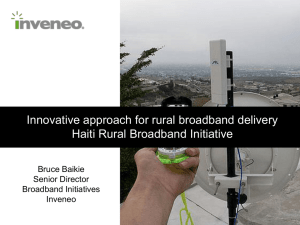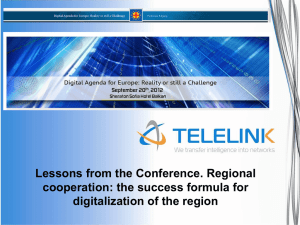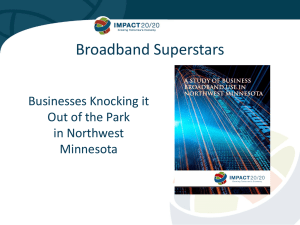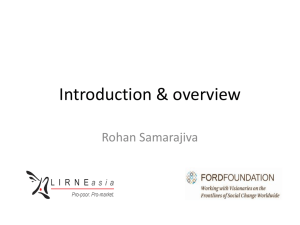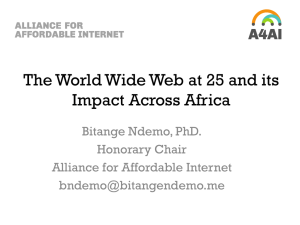Uhurunet: Delivering high capacity bandwidth to Africa`s businesses
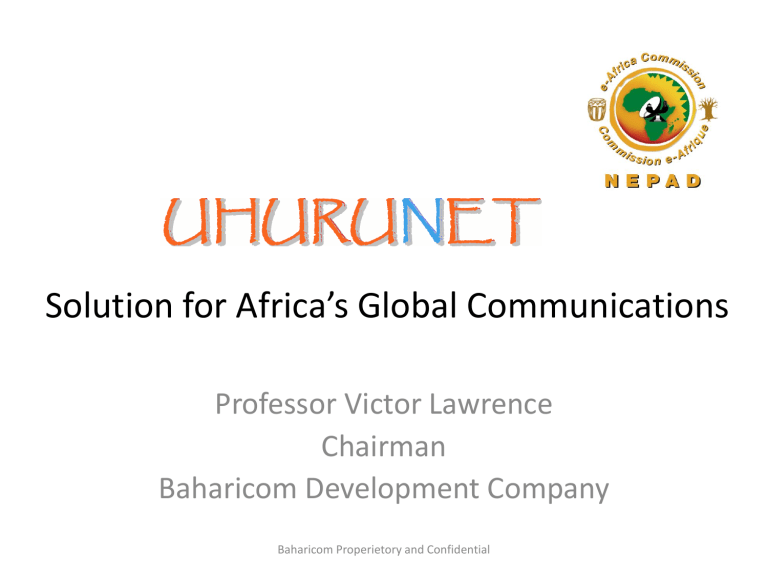
Solution for Africa’s Global Communications
Professor Victor Lawrence
Chairman
Baharicom Development Company
Baharicom Properietory and Confidential
Global Telecom Infrastructure 2009
Africa: Missing from the Global Telecom Infrastructure
The African Market is currently served by expensive, inconvenient, low quality telecommunication infrastructure consisting primarily of the SAT-3/WASC/SAFE fiber network and satellite service .
“Imagine a major research university with tens of thousands of students trying to access the Internet though a single US household.”
“The challenges the continent [of Africa] faces – meeting human needs, participating in the global economy, managing the environment, and improving governance – require engineers, doctors, scientists, and businessmen, all products of Africa’s universities. For years, strategies to address these challenges centered on providing direct assistance for combating disease and poverty and for providing food and water. But living conditions in Africa cannot be improved without sustained long-term economic growth. That goal in turn requires connecting Africa to the rest of the world.”
Calestous Juma
Professor of the Practice of International Development, Harvard Kennedy School
Cambridge, MA.
Elisabeth Moyer
Assistant professor in the Department of Geophysical Sciences,
University of Chicago, Chicago, IL and former lecturer at the African Institute for Mathematical Sciences.
Africa in 2012
Sustainable Social and Economic
Development
• Requires
–
Education
—Broadband to 600,000 schools and universities
–
Healthcare
—ICT healthcare systems to remote regions and cities
–
Agriculture
—state of the art methods and information
– Infrastructure
—Government and community ICT access
– Civil society
—modern knowledge transfer systems
• Uhurunet’s Broadband Capacity Grants will meet these needs!
The Need
Africa is the last frontier of the global fiber optic network infrastructure. Uhurunet has been launched in order to meet the need for Internet, data, and voice services in Africa that local service providers have been unable to provide adequately or economically through existing cable networks and satellite facilities.
Underpinning Uhurunet’s business rationale is the concomitant recognition that Information
Communication Technologies (ICT) are essential to Africa’s economic development and that Africa, although one of the fastest growing telecommunications markets in the world, lags far behind the rest of the world, because of the scarcity of broadband capacity which is generally supplied by submarine fiber optic systems. The statistics are alarming:
• Africa's bandwidth per capita is only 1% of the world average
• Only 4% of Africans have access to the Internet
• Africa has the highest connectivity costs in the world
• African universities pay some 50 times more for bandwidth then do similar institutions in the United
States
• Connectivity costs per GDP is almost 200 times higher than in the United States
Uhurunet’s business is therefore also its social mission—to deliver capacity to Africa’s businesses, schools, communities, civil society and governments.
Victor
ICT Penetration in Africa is Still the Lowest in the World
Sub-Saharan Africa is an under-served market across telecom services
Despite the high rate of growth of mobile telephony in
Africa, penetration rates still lag both developing and developed markets
Internet usage remains at extremely low levels given the high cost and limited availability of services
Future broadband penetration growth is expected to be mainly driven by mobile broadband
As African countries continue to transition from 2G to
3G technology, the use of mobile broadband will continue to rise
Falling connectivity prices from new submarine cable capacity in East and West Africa will promote a rapid increase in telecom services
Estimated capex of key African operators Bharti, MTN,
Vodacom and Millicom to be invested in African networks from 2010 to 2012 amounts to $12 billion
ICT Penetration Rates: Africa vs. Rest of World
60
59.0
49.0
50
40
32.0
30
23.0
20
19.0
13.0
15.0
10
0
Mobile
Cellular
Subscriptions
Fixed
Telephone
Lines
World
1.0
4.0
6.0
3.0
0.1
6.0
2.0
0.9
Internet
Users
Fixed
Broadband
Subscribers
Developing Countries Africa
Mobile
Broadband
Subscriptions
[ 7 ]
ITU, 2008; Broker research
Victor
Internet Usage in Africa
Online Penetration in Africa 2
In 2008, Africa had 32.1million internet users
Nearly 8 times as many as in 2000
Only 0.6 million fixed broadband internet subscribers
Penetration still lies far below world averages
One per thousand in Africa vs. two hundred per thousand in Europe
According to ITU, African consumers pay the highest broadband costs in the world
ICT costs amount to 41% of average monthly income while internet penetration is only 4% 1
Lower broadband cost seen as key political and economic factor by governments and international agencies
Numerous initiatives in the region to boost broadband penetration
Cape Verde
S. Tomé & Principe
South Africa
Senegal
Uganda
Nigeria
Gabon
Gambia
Botswana
Zambia
Namibia
Togo
Ghana
Lesotho
Côte d'Ivoire
Angola
Cameroon
Rwanda
Eritrea
Equatorial Guinea
Malawi
Guinea-Bissau
Benin
Mozambique
Madagascar
Tanzania
Chad
Mali
Guinea
Burkina Faso
Burundi
Niger
Liberia
Congo (Dem. Rep.)
Central African Rep.
Ethiopia
Sierra Leone
Africa Average
0.5
0.5
0.4
0.4
0.4
0.2
2.2
2.1
1.7
1.6
1.6
1.3
1.2
1.0
0.9
0.9
0.7
3.4
3.1
3.0
3.0
3.0
2.3
4.2
3.6
5.4
5.2
8.6
8.0
7.8
7.3
6.7
6.5
6.2
5.8
15.5
World Average
19.0
0 5 10 15 20
Source: International Telecommunication Union (ITU) World Telecommunication/ICT Indicators database
Notes:
1.
2.
[ 8 ]
ACE Landing Points Per 100 Inhabitants
The ITU’s ICT Price Basket shows how much countries are paying for telecommunication services, relative to income levels. It is composed of three sub-baskets: fixed telephone, mobile cellular and fixed broadband Internet tariffs. The ICT Price
Basket is computed as the sum of these three tariffs, as a percentage of monthly Gross National Income per capita
Internet users per 100 inhabitants in Africa, 2008
25
Victor
Internet and Broadband Growth in Western Africa
African governments recognise broadband as key enabler of socio-economic development and GDP growth and therefore have begun to prioritise accessibility and affordability of broadband services
As African markets have historically been sensitive to price reductions, competition should bring about a growth in internet and broadband
Increased access to end-users and all operators
Increased penetration rates in the region
In 2009, Tanzania experienced rapid growth in broadband penetration as customers and operators benefitted from connectivity to the new undersea cables
According to industry research, the number of broadband subscribers in Africa is expected to grow by 18% CAGR over the next 5 years
Africa Mobile Broadband Subscriber Growth
20
18
16
14
12
10
8
6
4
2
0
1
2
6
2009E 2010E 2011E
11
2012E
19
2013E
[ 9 ] International Telecommunication Union (ITU), African Alliance, Pyramid Research, Pioneer Research, Morgan Stanley Research (The Mobile Internet Report, 15-Dec-2009)
Broadband Capacity for Africa
The ongoing liberalization of Africa’s telecommunications regulatory regimes as well as accelerating economic development in Africa have led to explosive growth in the telecommunications sector.
Consistent with global trends, approximately 95% of international traffic is forecasted to be driven by Internet data access.
With historically low internet penetration rates in Africa in comparison to levels elsewhere, demand for data access in these regions is expected to continue to grow at a rapid pace.
Broadband internet access and heavier, content-rich traffic are expected to fuel strong demand for international connectivity via submarine fiber optic systems over the next 15 years.
Today, lack of international connectivity, diversity, and the corresponding use of scarce and expensive satellite resources are limiting Africa telecommunications development.
To achieve the forecasted growth, Africa needs a new international highway with a complete connectivity
Africa – tomorrow capacity
Uhurunet will support the growth of the traffic between Africa and the rest of the world, thus reducing the digital divide and driving the economic and social development of Africa
Uhurunet Objectives
Provide international connectivity to Countries (including landlocked Countries ) who don’t have access to any submarine cable
Improve connectivity, provide diversity and traffic securization to
Countries
• Reduce the cost of international traffic
• Speed up the development of broadband services
• Favor economic development and education
Uhurunet, a high connectivity
1
• A 17,000 km long Submarine
Cable designed to provide 5.12
Tbps
• 22 Countries to be connected, including 9 Countries not served today by a cable system
4
2
3
The best connectivity ever offered by a submarine cable along the West Coast of Africa
5
6 7
8
9
10 11
12
13
18
14
15
16
17
19
20
21
22
Uhurunet members
•
Baharicom
• Benin Telecoms
• Camtel
• Côte d’Ivoire Telecom
• CST (Sao Tomé)
• Expresso Telecom
• France Telecom
• Gamtel
• Getesa
• International Mauritania
Telecom
• Libtelco
•
Maroc Telecom
• Mauritius Telecom
• OCPT (DRC)
• Orange Cameroun
• Orange Guinée
• Orange Mali
• Orange Niger
• Republic of Gabon
• Sierra Leone Cable Ltd.
• Sonatel
• Sotelgui
Uhurunet—An Innovative System
•
Consortium members can aggregate their investment to finance the same landing point
•
Increased competition for international traffic in all Countries, for the benefit of the end user
•
Operators in Landlocked Countries are members of the Consortium.
•
Uhurunet is a state of the art and upgradeable system, ready for 40G implementation.
Philanthropic Strategy
The Uhurunet
Capacity
Endowment is a philanthropic initiative of
Baharicom and
Phelps Stokes to distribute broadband capacity grants to schools, universities, healthcare initiatives, NGO’s, and public service programs across
Africa.
Philanthropic services to promote social and economic development throughout Africa.
The Phelps Stokes Fund will raise at least $60 million from philanthropic donors and other sources to fund the purchase of broadband capacity from Baharicom that will make up the corpus of the Uhurunet Capacity Endowment
(the Endowment).
The Endowment will be formed as a pool of capacity units on the Uhurunet system through purchase or a presale of capacity on an right of use (ROU) basis made in advance of the system’s construction.
Page 16
Baharicom Laboratories
Technology Solutions for
Baharicom Properietory and Confidential
Facilitating the Dissemination of ICT Knowledge Capital in the Service of African Development
Why Baharicom Labs
• Research and study unique attributes of the African Information and Telecom market to
– communicate, interact and/or partner with global players through focused conference, trade shows , and literatures.
– identify niche opportunities and provide solutions internally, through partnerships or outsourcing (to academia and/or industry).
• Provide leapfrog solutions to help Africa’s Development competitively and to attract
– global institutions such as Google, Yahoo, Facebook, YouTube, IBM, etc.
– African service providers to facilitate new or unique services
• Transfer technology across product or service life cycle
• Development of human capital for the African technical industry
Baharicom Properietory and Confidential
Vision Statement
• Vision – Develop a state of the art research center to provide the most appropriate information and communication technologies and processes to enrich African people’s quality of life.
Baharicom Properietory and Confidential
Baharicom Labs Mission
An Independent Industrial Research Laboratory
To assemble and create technological capabilities for African communities to thrive their standard of living
To develop and deploy an array of ICT utilities, applications and practices optimized for and broadly supportive of African development
Coordinate & facilitate projects, stakeholders and technology development to accelerate the effective transmission of appropriate methods
To act as a hub and center of excellence at the core of ICTcentric activities
Sample Programs
• Information and Communication Technologies(ICT)
– Traffic monitoring and data mining of Uhurunet and Umojanet
– Security services; e.g., encryption, authentication
– Develop appropriate User Interface solutions
– Mobile social computing for the next billon users
• Rapid deployment of ad hoc technologies to provide ICT infrastructure for health or emergency applications
• Distance learning and research capabilities (a 21 st century digital arts and sciences academy for Africa)
• Integrate Africa into international eCommerce Network
• Engage with international philanthropic organizations to design, prototype and/or deploy life-enhancing solutions
Baharicom Properietory and Confidential
Operations
Baharicom Labs will achieve its goals through the following activities:
• Intellectual Property: Developing and managing a portfolio of intellectual properties
• Industry/Academia Bridging (Ventures): Actively search the industry and academia for niche technologies that are aligned with the goals of BDC and help advance ideas, prototypes and IPs into products through direct funding and/or partnerships.
• Market Research: Continual market and technical research culminating in literature provided to affiliates.
Baharicom Properietory and Confidential
Baharicom Labs
• Baharicom Labs will develop:
– A state-of-the art research center
– New ICT services for ISP’s and telecom carriers
– ICT health and education applications
– A network operating center
– A 21 st century digital arts and sciences academy
– Provide training in ICT skills
Page 25
Technology
for
Baharicom Properietory and Confidential
Undersea Fiber Optic Network
Components
Terminal
Branching
Unit
Repeater
Line
Terminating
Equipment
Traffic
Undersea
Network
Management
Equipment
Cable
High
Performance
Power Feed
Equipment
Optical
Equipment
Undersea Fiber-Optic Cable
OPTICAL
FIBER
STRENGTH
WIRES
UNIT
FIBER STRUCTURE
COPPER
SHEATH
INSULATION
JACKET
ARMORED PROTECTION
LAYER

